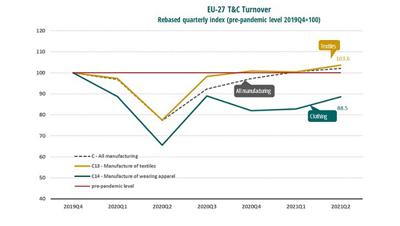Statement by Thomas Waldmann

Thomas Waldmann, Managing Director, VDMA Textile Machinery Association (Source: VDMA)
Europe's economy faces major challenges and problems. Since the beginning of the eurozone crisis in 2009, Europe has experienced a series of challenges, including a massive influx of refugees, Brexit, the corona virus pandemic, and the Russian invasion of Ukraine. Being globally connected this also impacts the textile industry. We asked different stakeholders in our industry the question: “What are the biggest challenges in the textile industry for 2023?” In his statement Thomas Waldmann, Managing Director, VDMA Textile Machinery Association, Frankfurt/Germany, gives us his assessment:
The 5 challenges [of energy, skills shortages, supply chain & raw material issues, sustainability & climate protection, and traceability] are certainly of great importance. However, I think that although they can be quickly ranked from 1 to 5 in terms of importance, in the end a ranking cannot adequately reflect the many dimensions of the challenges. On one hand, there is the aspect of whether one is looking at the textile industry and its many value-added stages or, for example, textile machinery manufacturing. In addition, there are major regional or even continental differences in the individual challenges. For example, energy is certainly one of the biggest challenges at present, especially in Germany and Europe, but not in many other parts of the textile world. The challenge of sustainability and climate protection will probably only reach its full momentum over the course of the years. The challenge of a lack of suitable young talent is the most likely to run through many textile value-added stages and also world regions in which the textile industry is located.
And in textile machinery manufacturing, of course, all these challenges also exist. But in view of a considerable decline in textile consumption in China and other consumer markets, a drastic drop in orders can be observed or is at least imminent. These phenomena are not new in textile machinery manufacturing, but the general conditions are different from those in the textile industry. Textile companies can usually get by for a longer period of time with a reduction in capacity utilization of a few percentage points, but most of them then cut back on investments. For a textile machinery company, a resulting delay in machine purchases is usually associated with comparatively stronger declines in turnover and is only possible for a foreseeable period of time. In this respect, one of the main challenges for the textile machinery industry in 2023 will certainly be to cope with the expected lower order volume and to prepare well for a strong recovery in demand. This is because the fundamental demand drivers, such as the growing world population, the increase in purchasing power in emerging countries and ever new fields of application for functional textiles, continue to exist in principle and are being expanded by the technical requirements for recyclable textile production.



